
The ROI in workplace mental health programs: Good for people, good for business A blueprint for workplace mental health programs
30 minute read
04 November 2019
A study of Canadian companies reveals a clear positive ROI for workplace mental health programs—and points the way forward for companies seeking to invest in workers' mental health.
Executive summary: A positive ROI on mental health investments is well within reach for Canadian employers
Poor mental health among the workforce imposes tremendous costs on Canadian employers. Yet barriers to investment in workplace mental health remain, including a lack of knowledge of best practices, as well as a lack of evidence that such investments can have a positive impact on the bottom line.1 To overcome these barriers, Canadian employers require real-world evidence that workplace mental health programs are an investment that yields valuable returns, rather than a cost. This study, the first of its kind conducted within the Canadian context, provides such evidence.
Learn more
Explore the Talent collection
Subscribe to receive the latest from Deloite Insights
Download the Deloitte Insights and Dow Jones app
Based on an analysis of historical investment and savings data from seven Canadian companies at various stages of their mental health investment journey, and complemented by interviews with subject-matter experts and leaders from 10 companies, we examine the typical annual return on investment (ROI) of workplace mental health programs, unearth common challenges and enablers of program success, and identify leading practices for employers to consider.
Throughout this study, we heard that employers would like access to information and tools to make evidence-based decisions about how to invest in mental health and maximize program benefits. Employers must also be equipped to measure and track outcomes and benefits, just as they would other portfolios of investments across their business. To this end, the report includes a blueprint for a phased program implementation and an approach to measure the outcomes of workplace mental health programs.
Key takeaways for decision-makers
Based on 10 companies’ real-world experiences and an analysis of seven of these companies’ data, positive ROI on workplace mental health initiatives is within Canadian organizations’ reach. The median yearly ROI on mental health programs was CA$1.62 among the seven companies that provided at least three years’ worth of data. Companies whose programs had been in place for three or more years had a median yearly ROI of CA$2.18. Programs are more likely to deliver greater returns as they mature, rather than yielding immediate financial benefits. Indeed, achieving positive ROI can take three or more years.
Organizations investing in workplace mental health programs appear to be mitigating the rising costs of doing nothing. On average, mental health issues account for 30 to 40 percent of short-term disability (STD) claims and 30 percent of long-term disability (LTD) claims in Canada, with the prevalence of claims for mental health diagnoses climbing by 0.5 to 1 percent every year. In this study, mental health-related STD claims accounted for 30 percent of total claims in 2018 and only increased by one claim per 1,000 full-time employees (FTEs) from 2016 to 2018. Even companies that have mental health programs in place but have not yet achieved a positive ROI may be realizing greater savings than the national average, reducing the cost of doing nothing. Since greater productivity is closely linked to lower absenteeism, these companies are also likely elevating employee productivity.
- Invest in proactive programs that promote positive mental health in addition to treatment—this means going beyond delivering interventions for poor mental health to also promote positive mental health and well-being
- Prioritize investments in the highest-impact areas, such as leadership training and return-to-work programs
- Track key performance indicators and calculate ROI to demonstrate the financial and nonfinancial benefits of mental health programs
- Use data analytics to evaluate whether investments are having the desired impact and adoption rate, and adapt programs based on results
Investing in high-impact areas to better support employees can boost ROI. Mental health programs are more likely to achieve positive ROI when they support employees along the entire spectrum of mental health, from promotion of well-being to intervention and care, as well as the elimination or reduction of workplace hazards that could psychologically harm an employee. In our study, the seven companies that provided three or more years’ worth of data achieved greater program ROI by prioritizing investments in high-impact areas such as leadership training and preventive interventions, including employee and family assistance programs and psychological care benefits.
If leaders take the time to measure their baseline data and take stock of existing initiatives, many would realize that they have already started to use the right tools to support workplace mental health.
Very few organizations start from scratch. Canada's Psychological Health and Safety in the Workplace national standard (the Standard), published in 2013, provides a comprehensive framework for organizations to promote mental health and prevent psychological harm among employees. But companies do not need to formally adopt the Standard in its entirety all at once. Instead, companies should understand that implementing the Standard is an iterative process, beginning with identifying workplace issues in their organization using baseline data and then making incremental improvements over time. If leaders take the time to measure their baseline data and take stock of existing initiatives, many would realize that they have already started to use the right tools to support workplace mental health.
Performance measurement is an often-overlooked but critical element of program implementation, and should not be underestimated. Performance measurement—tracking key performance indicators, assessing the effectiveness of interventions with employees, and regularly calculating ROI—is a key element of workplace mental health programs that is often overlooked. Putting in place mechanisms to measure performance can enable organizations to achieve desired program impact, improve adoption rates, and enhance decision-making.
As the leading cause of stress for Canadian employees, workplace pressure has a tremendous impact on employees’ mental health. Because employees’ mental health is linked to both financial and nonfinancial outcomes, employers have an opportunity to reap benefits in both realms by implementing workplace mental health programs. Perhaps most importantly, demonstrating a commitment to employees’ mental health and well-being is becoming central to positioning the company as one that employees, customers, and society at large are proud to support.
Now, more than ever, a mentally healthy workplace matters
Organizations depend on their employees to deliver their mission, vision, products, and services to drive overall success. Creating a healthy and safe workplace, one that protects both the physical and mental health of employees, is essential to achieving business objectives and shareholder returns. Clearly, investment in a mentally healthy workforce is required. But how should organizations go about it?
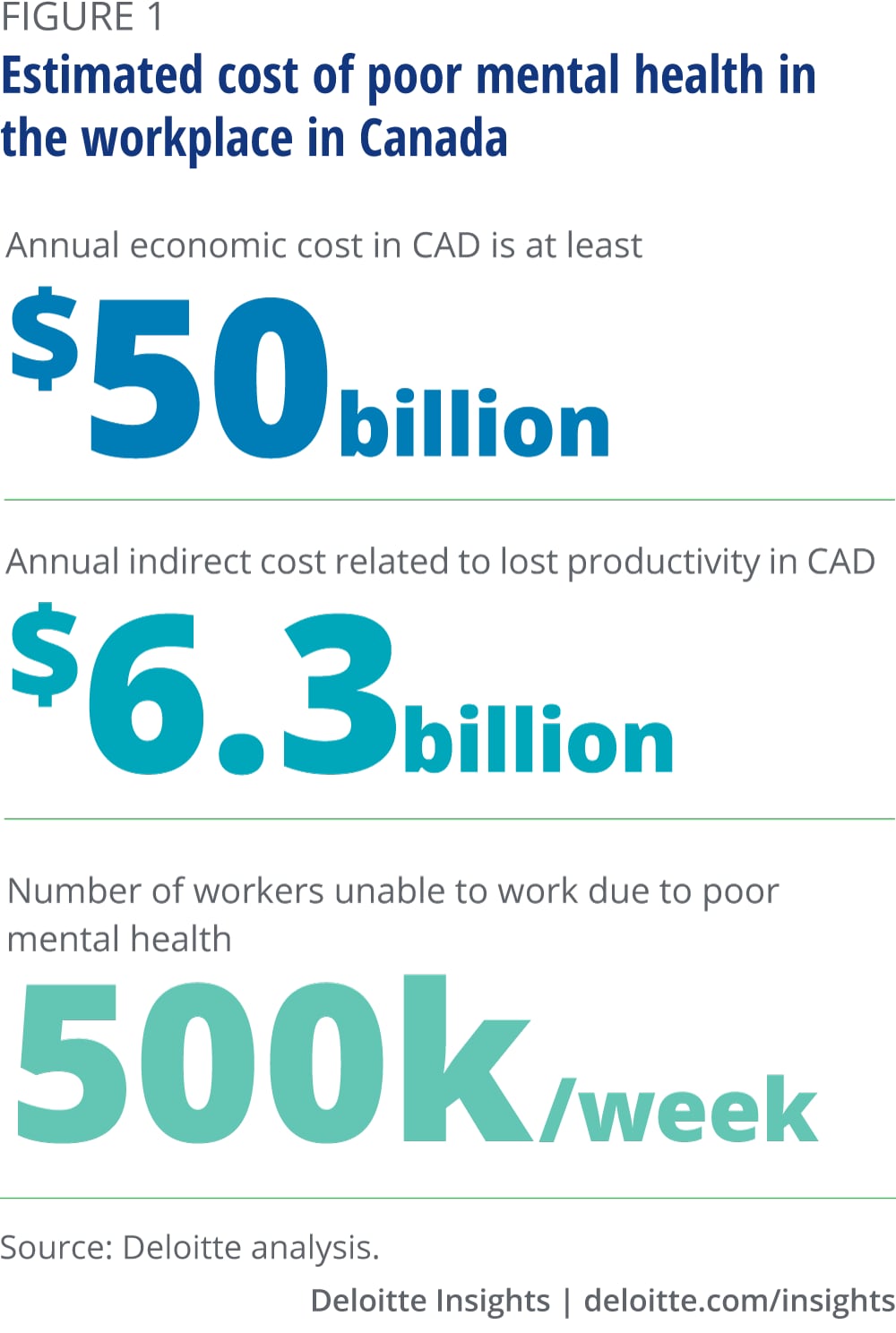
The business costs of poor mental health in the workplace are staggering, with 30 of every 1,000 Canadian employees missing work for mental health reasons each week. In total, the loss of productivity at work due to mental illness–related absenteeism and presenteeism (working while unwell) adds up to CA$6.3 billion annually across Canada.2 Costs associated with poor mental health include not just the cost of treating mental illness (for example, therapy and medications) but also the costs incurred when—as often occurs—poor mental health exacerbates the negative impacts and health care costs of other chronic illnesses, such as cardiovascular disease and asthma.
The World Health Organization estimates that poor mental health costs the global economy US$1 trillion annually in lost productivity. In Canada, the estimated economic cost is at least CA$50 billion per year, with direct costs related to health care, social services, and income support making up the largest proportion (figure 2). An additional CA$6.3 billion of indirect costs stems from lost productivity, with 500,000 Canadians unable to work each week due to mental health problems or illnesses.

As organizations seek to support employees’ mental health, and attention on the issue of mental health grows, both in Canada and internationally, progress on a range of mental health policies, laws, programs, and services has been made. Canada's Psychological Health and Safety in the Workplace national standard (the Standard), released in 2013, provides a comprehensive framework for organizations to promote mental health and prevent psychological harm among employees (appendix A).3 The Standard is intended to reduce risks related to mental health, promote productivity and engagement, reduce liabilities related to employee mental illness, and develop and continuously improve workplace environments.4 The first of its kind, this voluntary standard is a major step forward for workplace mental health in Canada—a rigorous approach to teaching employees about mental health, destigmatizing mental illness, and increasing awareness so that workplace behavior promotes psychological safety. It is accompanied by a step-by-step guide to help organizations with implementation.5
Even with the Standard available, only one-third of Canadian employers have a mental health strategy in place, and most of those organizations are not yet measuring the outcomes of their investments.
Even though the Standard is available, only one-third of Canadian employers have a mental health strategy in place,6 and most of those organizations are not yet measuring the outcomes of their investments. Further, workplace stress remains the leading cause of employees’ mental health issues,7 and 70 percent of Canadian employees are concerned about the psychological health and safety of their workplace.8
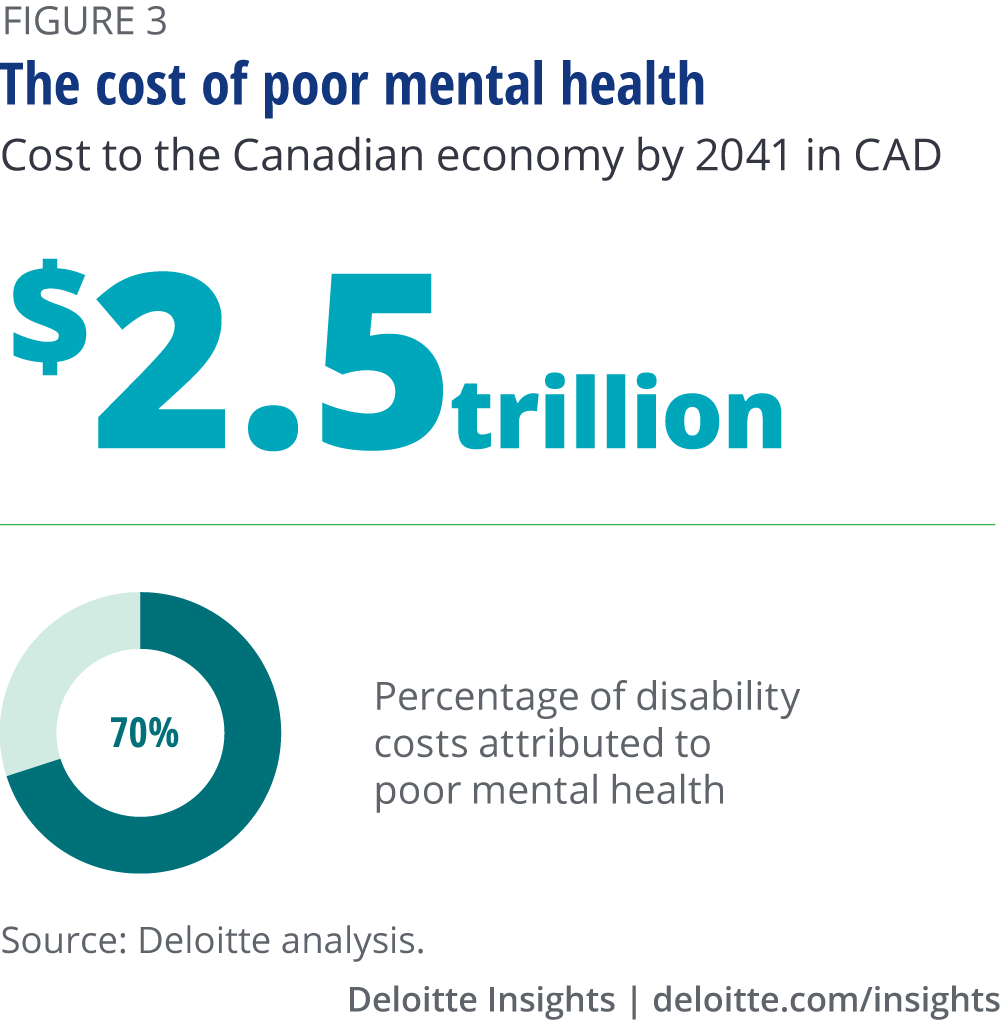
Considering mental illness accounts for roughly one-third of short- and long-term disability (STD and LTD) claims but 70 percent of workplace disability costs, the opportunity to generate savings is clear. There is evidence that workplace programs that include mental health intervention, access to clinical treatment, and support to navigate disability management services have achieved positive results such as reduced absenteeism and improved productivity and financial outcomes. Evidence also exists that investing in employee mental health is good for business. A comparative study of the stock performance of companies represented on the S&P 500 Index found those with high health and wellness scores (based on associated program delivery in the workplace) appreciated by 235 percent, compared with the overall S&P 500 Index appreciation of 159 percent over a six-year period.
However, evidence from individual companies or sectors has, to date, been hard to collect. For several participating companies, collecting data for this study was the first time they had requested certain program-related key performance indicators (KPIs) from insurance providers, showing that data collection and analysis of finance-related program outcomes is relatively nascent or nonexistent. To strengthen the business case for investing in workplace mental health programs, employers must understand the financial and nonfinancial benefits of those programs and establish mechanisms to measure and maximize programs in order to realize those benefits.
A case for investing in workplace mental health: Bell Canada
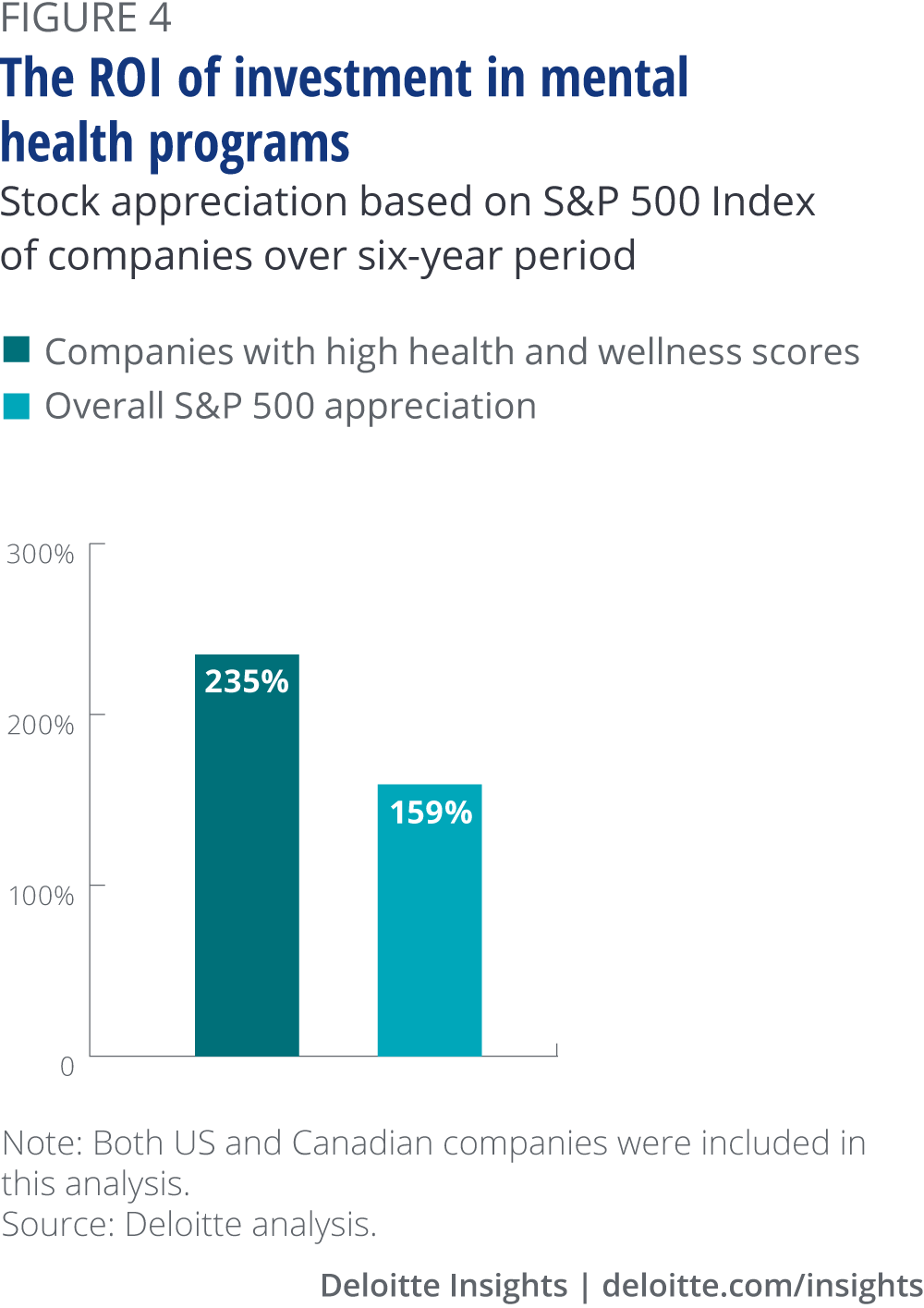
What does investing in employee mental health look like in practice? Typically, it takes a combination of workplace programs, practices, and policies. These may include leadership training and buy-in, employee awareness and educational initiatives, employee and family assistance programs (EFAP), psychological care benefits, appropriate processes related to taking leave and returning to work, and policies that promote mental health and well-being. Organizations should implement these components to form a workplace mental health program that supports their employees’ mental well-being and, ultimately, workplace productivity.
The experience of Bell Canada (Bell) is instructive in this area. Bell is a Canadian telecommunications company providing advanced broadband communications networks and services to consumers and business customers across the country. Bell's workforce comprises more than 52,000 team members, with approximately 44 percent of total employees represented by labor unions in 2018.
A champion for mental health in Canada
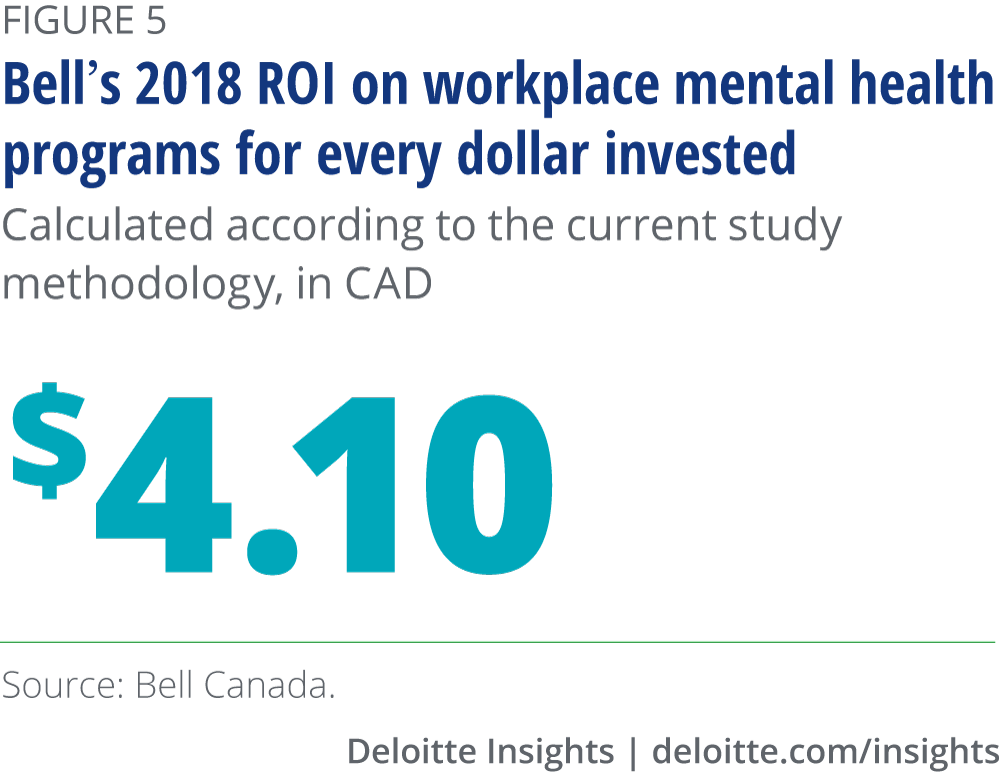
“Bell Let's Talk” is the largest-ever corporate initiative supporting Canadian mental health. Launched in September 2010, Bell Let's Talk promotes awareness and drives action with a strategy built on four pillars: fighting the stigma of mental health, improving access to care, supporting research, and—most relevant to this study—leading by example in workplace mental health. In alignment with the Standard, key elements of the initiative include an enhanced return-to-work (RTW) program, improved accessibility of resources and tools, mandatory leader training, and cultivating a culture of support.
For the past seven years, Bell has measured a positive ROI on its investment in workplace mental health.
Performance measurement for positive returns
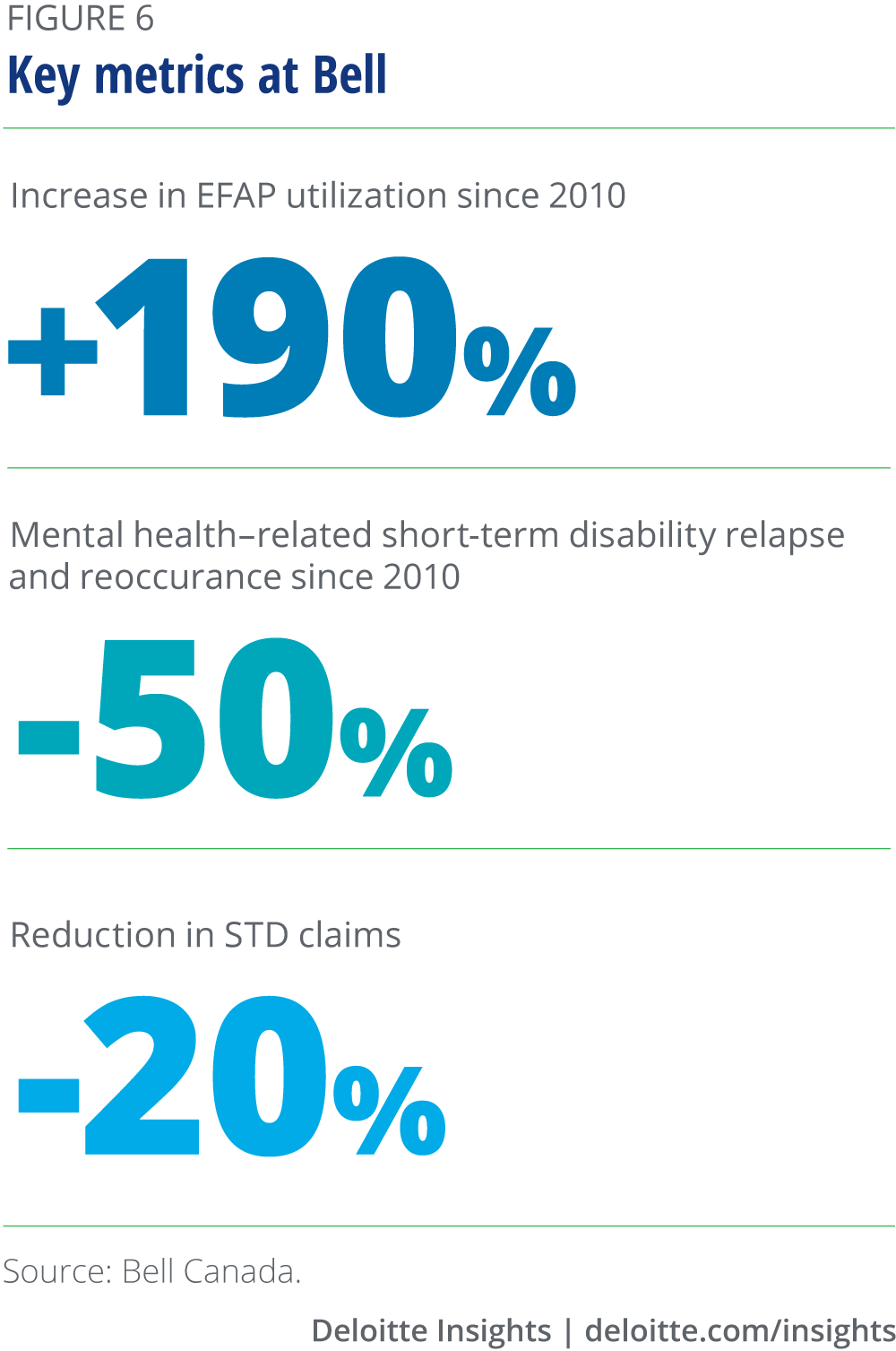
Since 2010, Bell has tracked over 90 KPIs using a mental health scorecard, including indicators related to STD and LTD claims, usage of benefits and programs supporting mental health, and employee engagement. Using this scorecard to measure progress against program objectives has been critical to understanding the program’s impact since 2010. For the past seven years, Bell has measured a positive ROI on its investment in workplace mental health.
“Supporting the mental health and safety of our people is equally important to supporting their physical health and safety,” said Bernard le Duc, EVP and CHRO, Bell.
Bell has significantly increased its benefits coverage for psychological care for Bell employees and their families, and provides support through the EFAP to manage employees' total health needs. Since 2010, overall usage of EFAP has reached 36 percent, more than double industry and national norms, and a 190 percent increase compared with 2010 usage. Bell has also recorded a 20 percent decrease in STD claims related to mental health, demonstrating how proactive support can have positive downstream impacts.
Bell’s RTW program aims to increase support for employees facing a mental illness and their leaders through early intervention and communications. This initiative provides an RTW checklist and training to support leaders and employees through the process, and utilizes an online accommodation tool to improve the employee experience. As a result, Bell has seen its employees’ mental health–related short-term disability relapse and recurrence decrease by over 50 percent from 2010 baseline levels.
Going forward, the scorecard will help Bell evolve its program by continuously assessing program effectiveness in supporting workplace mental health. The scorecard has also supported positive discussions across the business with respect to the value and purpose of workplace mental health initiatives within the company.
Better support during short-term disability leave and return to work leads to a reduction in long-term disability claims, a key element of cost saving.
As le Duc put it, “You need to work at all levels for initiatives to work and be sustainable. Where we are at today, we are now able to have more progressive discussions. We are able to demonstrate the benefits of programs such as early return to work through reductions in relapse and recurrence of mental health challenges.”9
A strategic approach to workplace mental health investments pays off for Canadian companies
Our ROI analysis suggests that employers might already be achieving benefits from workplace mental health programs in Canada, and those benefits are not confined to the financial. Organizations may be able to use our ROI calculation methodology to equip decision-makers with the information needed to make strategic investments.
Workplace mental health programs pay off, and some program components are more valuable than others
Based on our analysis, mental health programs are more likely to achieve positive ROI when they support employees along the entire spectrum of mental health, from promotion of well-being to intervention and care, as well as mitigating risk factors in the workplace. Programs are also more likely to see greater returns as they mature, rather than yielding immediate financial benefits. Indeed, achieving positive ROI can take three or more years—a point we discuss in more depth later in this report.
The median yearly ROI among the seven companies able to provide at least three years of data was CA$1.62. Companies with programs in place for three or more years had a median yearly ROI of CA$2.18, while most companies with programs implemented in the last three years had not yet achieved a return. This suggests that while companies may not immediately see a return, based on our research, they are likely to see a positive return over time as the program matures. This makes sense considering that improvements to individuals’ mental health can take time, and there may be a lag before investments translate into improvements to productivity.
Companies with a positive ROI tended to focus investment across the spectrum of mental health.
Of the seven companies that were able to provide three or more years’ worth of historical data, four demonstrated a positive ROI in at least one year over a three-year span. Companies with a positive financial ROI tended to focus investment across the spectrum of mental health, including promotion (for example, leadership and employee training), treatment (for example, EFAPs and psychological care benefits), and RTW activities. Interestingly, all four companies showing a positive ROI began investing in their workplace mental health programs in 2012 or earlier, and they were among the top investors when considering dollars per FTE invested specifically in workplace mental health.
Study methodology: Calculating the ROI of workplace mental health programs
We asked companies participating in this study to provide a minimum of three years’ worth of historical data, including data for a baseline calculation representing the year in which investment began. Ten Canadian companies (“participating companies”) volunteered data; of these, seven companies provided enough data to support a calculation of the financial ROI of workplace mental health programs.
In the ROI calculation, we considered a range of costs related to program investments (for example, training and workplace events) and psychological care benefits, and compared these costs to savings related to STD and LTD claims as well as presenteeism (figure 7).
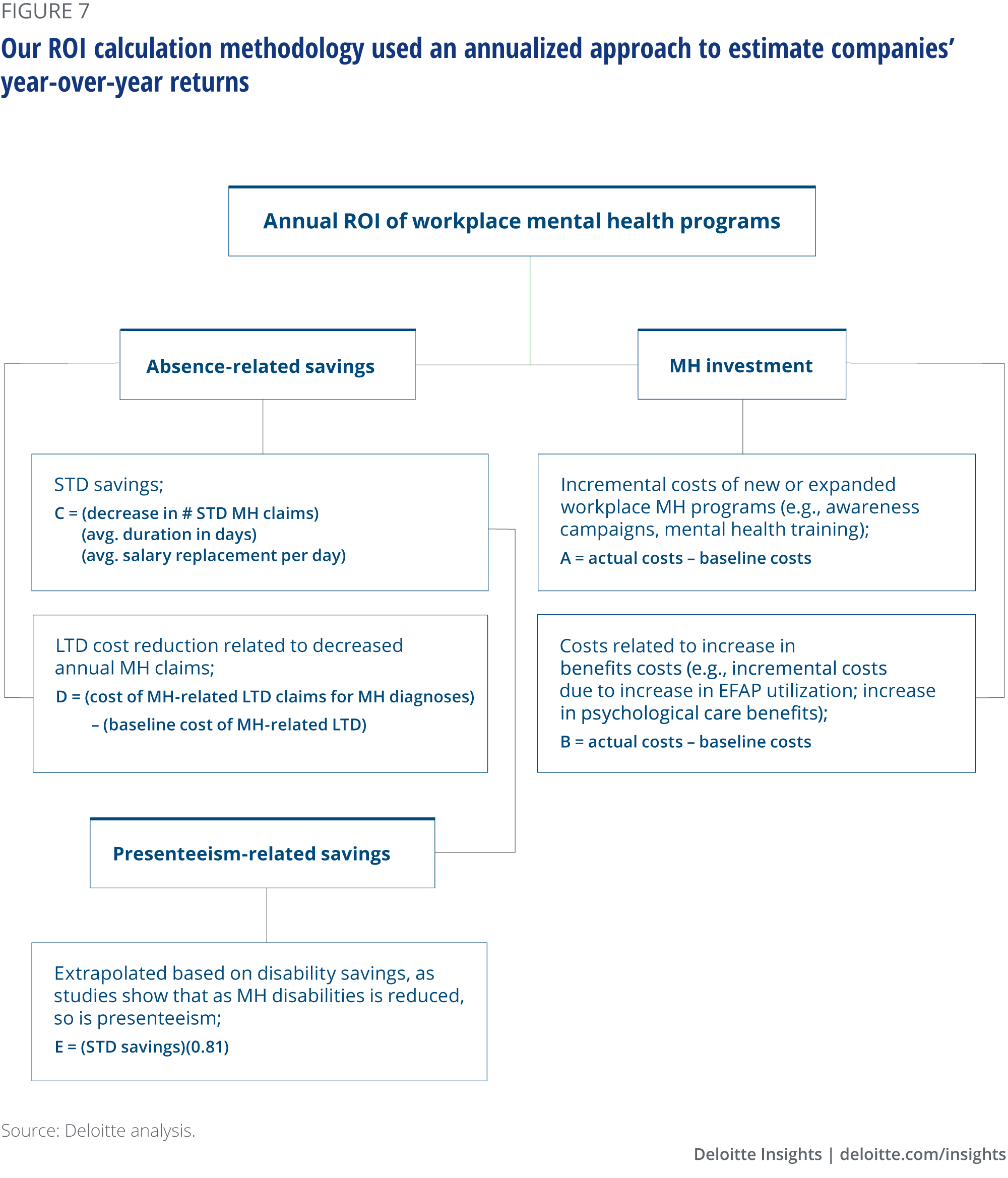
Using the methodology depicted in figure 7, we calculated the annual increase in costs and savings relative to the baseline year. Each company’s annual ROI in Canadian dollars was calculated using the formula:

In addition to calculating ROI for the seven companies with sufficient data, we conducted one-hour interviews with representatives responsible for workplace mental health initiatives from each of the 10 companies that initially provided data. The interviews were designed to understand the experience of developing, implementing, and running workplace mental health programs. They also aimed to understand programs’ real or perceived financial and nonfinancial ROI, as well as identify related enablers and barriers to success. Interviews with three subject-matter advisers from industry and academia further supported the qualitative analysis.
See Apendix B for details on your Study methodology.
Overall, among our total sample of 10 companies, spending on workplace mental health per employee has increased over the last three years (figure 8). On average, spending on programs and activities that support good mental health and minimize workplace risk factors increased by approximately 6 percent from 2016 to 2018. The steady increase in spending per 1,000 employees suggests that while leaders may not expect to see an immediate ROI from investment in programs, they recognize the importance and value of supporting a mentally healthy workplace.
Companies with a positive return have already started implementing elements of the Standard.
The average spend in each area provides a useful benchmark for companies interested in implementing a workplace mental health program. However, spending habits appear to be different among companies seeing a return and those that are not.

Most significantly, our research showed that companies with a positive ROI are investing less in areas that have not yet demonstrated a return. On the program side, companies with a positive ROI are more focused on training leaders, while those that have not yet demonstrated a return are investing more in training employees. Not surprisingly, companies with a positive return have already started implementing the Standard.
With regard to mental health support investments, companies with a positive return invested twice as much in psychological care benefits as their counterparts, and 10 percent more in EFAPs. Interestingly, drug costs related to mental health diagnoses for companies not yet demonstrating a return were more than double that of those with a positive ROI. Anecdotal evidence from interviews with company leaders suggests that companies with a positive ROI were able to lower drug costs over time due to more proactive management of mental health disability claims, more even usage of benefit offerings, and better understanding of well-being. These claims are supported by the fact that 75 percent of people prefer psychotherapy over medication, and psychological treatments are typically as effective in the treatment of mental illness as pharmacological treatments.10
Taken together, these findings suggest that employers could achieve greater program ROI by prioritizing investing in higher-impact areas such as leadership training and preventive interventions, including EFAPs and psychological care benefits.
Achieving positive ROI may take time
Demonstrating positive ROI for workplace mental health programs can encourage sustained, long-term program investments that are resilient to challenges such as leadership turnover and budget cuts. Monitoring the indicators we used to calculate ROI, such as those mentioned in the previous section, helps companies objectively track progress toward targets and areas for improvement over time. However, as we noted, companies beginning to invest in workplace mental health programs should not expect to see a positive return in the first year.
Our analysis indicates that it can take three or more years of investment to see returns. In fact, all of the companies in our sample with positive ROIs began investing in their programs in 2012 or even earlier—meaning that they have had six or more years to demonstrate ROI since they established their programs. While some companies have demonstrated a positive financial ROI within the first three years since program implementation, companies that began investing within the last two years likely need additional time before realizing positive ROI.
Organizations investing in workplace mental health programs seem to be mitigating the rising costs of doing nothing
Leaders may not be convinced about the ROI of mental health programs, but the alternative of doing nothing has a great and rising cost. A Deloitte study found that while average workplace absences per employee have fallen over the last decade, the proportion of days lost due to poor mental health has increased, making mental illness the fastest-growing disability claim type.11 This could mean that the incidence of poor mental health is increasing and/or that employees are beginning to seek the support they need when they need it, instead of continuing to work while unwell.
Even more worrisome is the finding that mental health-related presenteeism may cost employers up to three times that of absence—and that presenteeism is growing rapidly due to trends such as perceived job insecurity and remote working.12 While mental health promotion could be leading to an increase in mental health disability claims, there is still more work to do in order to discourage people from working while sick and encourage them to get help early on.
A shortage of recent data on national trends in mental health–related disability claims makes it difficult to determine the cost of doing nothing, though trends in STD and LTD claims suggest that employers already investing in workplace mental health may see the number of claims increasing more slowly than the national average. Figures 9 and 10 show that overall, the numbers of both STD and LTD cases for mental health diagnoses per 1,000 full-time equivalents (FTEs) have remained relatively stable over the last three years for companies participating in this study. Even more promising, the average number and proportion of LTD claims related to mental health has seen a slight decrease.
Even companies that have not yet reached a positive ROI may be realizing savings compared to the national average.

On average, mental health issues account for 30 to 40 percent of STD claims and 30 percent of LTD claims in Canada, with the prevalence of claims for mental health diagnoses climbing by 0.5 to 1 percent every year.13 That said, for companies participating in this study, STD claims for mental health diagnoses accounted for 30 percent of total claims in 2018, and only increased by one claim per 1,000 FTEs from 2016 to 2018. Compared to the broader trends within Canada, this indicates that even companies that have not yet reached a positive ROI may be realizing savings compared to the national average, or to the cost of doing nothing. Since absenteeism and productivity are closely linked, these companies are also likely boosting employee productivity.
Another disability claim metric with an impact on mental health program ROI is the average duration of disability claims. STD and LTD claims related to mental health diagnoses last approximately two times longer, are more costly than other claim types,14 and they show a greater-than-average relapse rate.15 In our study, five companies were able to reduce the average duration of mental health–related STD claims over a three-year period, creating another opportunity for cost savings. Three of these five companies have implemented return-to-work programs, which could be contributing to the decrease in absenteeism over time.
Leadership training and return-to-work programs have been identified as critical to creating a positive ROI.
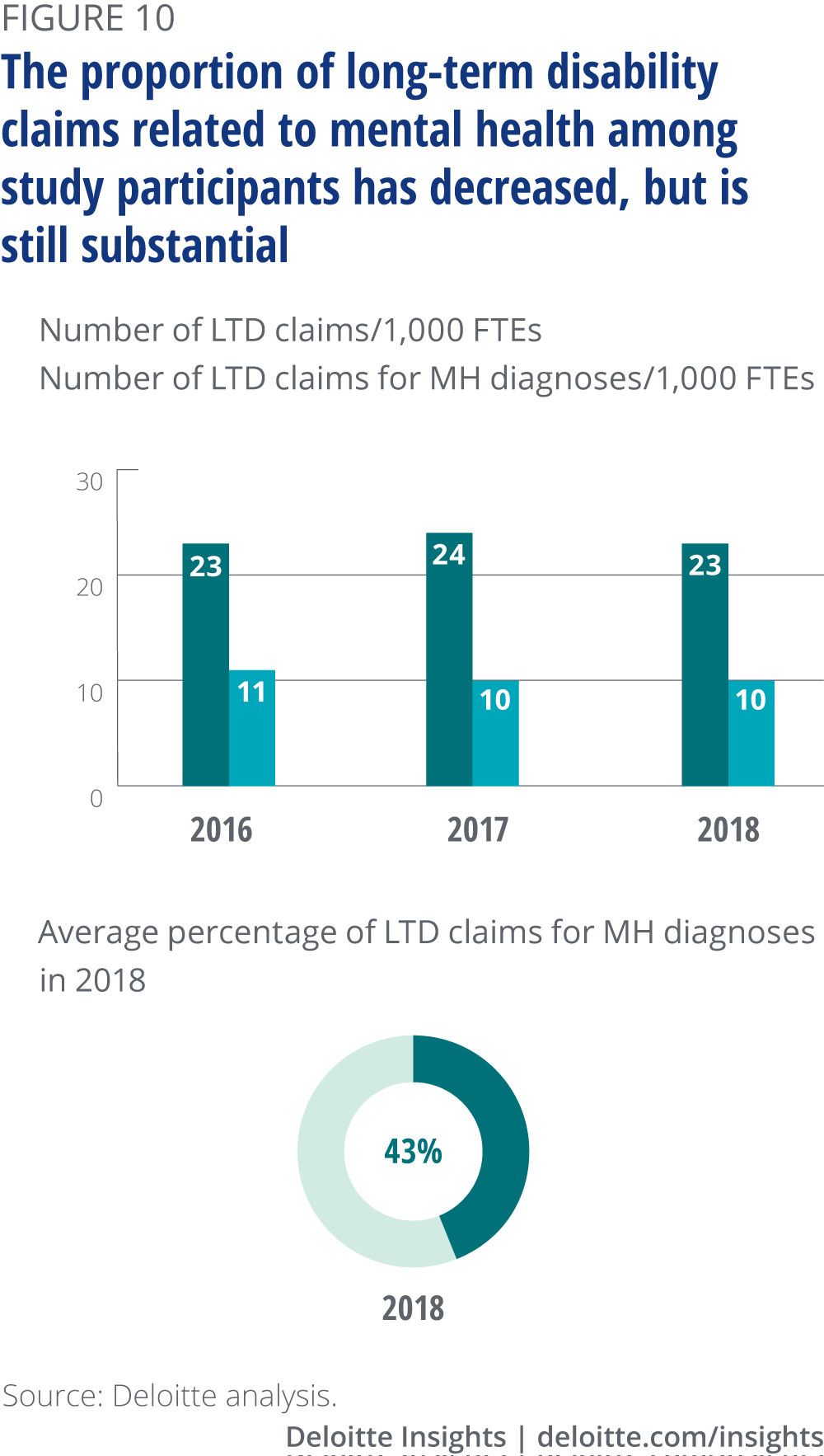
Some leaders may be concerned that if they begin to measure program outcomes, they might find themselves struggling to justify the expenditure. One interviewee went so far as to say that companies could become trapped by ROI numbers. However, our findings should somewhat alleviate concerns that investment may initially drive higher costs (for example, more STD and LTD claims), as they provide an appropriate rationale for sustained investment (and measurement) with an emphasis on return-to-work initiatives.
Mental health investments yield benefits well beyond productivity
The estimate of financial ROI in this study is conservative and does not consider the many other benefits that investment in workplace mental health programs can generate. Participating companies identified positive effects beyond productivity and cost savings, including:
Higher retention rates. Programs that support employees along the continuum of care, from mental health promotion to treatment for return-to-work, can decrease voluntary turnover related to mental health issues by supporting employees in need, so that they see alternatives to leaving the organization. Decreased turnover, in turn, reduces costs related to hiring and training new employees.16
Stronger talent attraction. Being recognized within one’s industry and nationally as an organization that creates a psychologically safe and mentally healthy workplace could help attract top talent. Boosting brand recognition and improving sentiment could be especially helpful in attracting younger talent. A Deloitte study indicates that millennials are more anxious and less optimistic than their elders, in large part due to the pervasiveness of news via technology.17 The future of work will require employers to account for this mindset, and that of multiple generations, to not only offer support for stress and mental illness but also aim to build resilience among the workforce.
Greater engagement. Workplace mental health programs can improve employee engagement as a collective measure of employees’ attitudes, attentiveness, and intensity of effort related to their work and workplace. In addition to improving productivity, mental health programs can improve employees’ attitudes toward coworkers with mental illness and their willingness and ability to identify, deal with, and provide help to people in mental health situations.18 Taking engagement a step further, companies can use engagement surveys to evaluate changes in workplace psychosocial factors, tracking the risks to employee psychological health and organizational psychological safety over time.19
Workplace mental health programs can improve employee engagement as a collective measure of employees’ attitudes, attentiveness, and intensity of effort related to their work and workplace.
More effective risk management. Employers are increasingly being held responsible in circumstances where they have failed to provide a psychologically safe workplace.20 Implementing the Standard and programs supporting employees’ mental health could help companies mitigate this risk.
Better alignment with shareholder priorities. Environmental, social, and governance (ESG) factors are becoming more important for investors, and workplace mental health is gaining recognition as an important component of good business. As a result, employers may feel increasing pressure to align with ESG criteria, such as those of the Sustainability Accounting Standards Board, which include employee health, safety and well-being, diversity and inclusion, and compensation and benefits.21
The road to positive ROI: A blueprint for implementation
Once employers have made the decision to invest in workplace mental health, they can consider several actions to boost the chances of realizing positive financial and nonfinancial returns. Organizations that are just beginning to explore investments in mental health programs often struggle with where to start; once on their way, they may also encounter common roadblocks. We identify critical considerations for implementation and outline a blueprint to get organizations headed in the right direction.
Drivers of—and barriers to—effective workplace mental health programs
While each company has a unique culture and context, our study uncovered several common drivers and barriers associated with realizing the financial and nonfinancial benefits of workplace mental health programs.
Factors hindering the success of companies’ mental health programs include:
The difficulty of implementing programs in large, complex, and highly decentralized companies. Change management is often a barrier in larger and more complex companies. In particular, acquisitions of new companies were commonly challenging for mental health programs owing to the tremendous pace of change and cultural shifts typical during an acquisition. According to one interviewee, “Accompanying employees through change is important. Some [business units] really focus on key performance indicators (KPIs)—we need to look at this with a human lens.”
Two companies in our study integrated aspects of their workplace mental health program into existing corporate policies and strategies. This integrated approach has woven psychological health and safety into the organizational fabric.
Other major changes can impede program implementation as well. One company found that, despite projected improvement in several metrics (for example, reduced absenteeism and shorter disability leaves), leadership turnover and major structural changes within the company resulted in a return to baseline level rates, reversing the progress that had been made.
Lack of financial, human, and program resources. One organization, despite having strong leadership and employee buy-in to move workplace mental health forward, has found that the combination of a small team and lack of resources is hindering its program’s progress. As one leader elaborated, “Our CEO talks about mental health a lot—for example, mental health in relation to the economy or in the community. This inspired a waterfall of people wanting to be part of it. But we are not currently equipped to handle the flood of interest. The best thing would be to have a bit of money and a couple more people to help.”
Companies that achieved greater returns invested in activities that support employees along the entire mental health continuum, promoting mental health and well-being among employees regardless of the current state of their mental health.
Factors that have helped programs succeed, or that are identified by experts and existing studies as important, include:
Prioritizing mental health at both the leadership and employee levels. For several companies in our study, the conversation about workplace mental health began at the board and executive levels because of increasing awareness of mental health as a workplace issue. As one interviewee mentioned, “It isn’t about reducing cost, but more about understanding. Our CEO noticed in the marketplace that we need to invest in our employees. The reality is that the statistic [that] one in five Canadians will personally experience a mental health problem or illness also affects our organization.” This leadership support has created two outcomes at the organization: securing budget for mental health programs across the organization, and shaping organizational culture to increase employee awareness of workplace mental health. At another company, said an interviewee, “Storytelling is becoming a big part of how we communicate. Getting leaders comfortable engaging conversations, creating podcasts and videos on mental health—it’s about spontaneous visibility.”
At the employee level, companies recognize the importance of mental health champions and communication through grassroots activities to promote mental health programs. For example, one company used its local office presence and technology to equip employees with resources to build resilience and change champions across the organization.
Recognizing that poor mental health is a top cost driver. Recognizing that poor employee mental health drives up costs was a common reason that participating companies began working toward and tracking program ROI. In particular, tracking the costs of disability claims related to mental health spurred leaders into action. Three companies worked with their benefits providers to collect data on different cost drivers related to benefits, including STD and LTD claims and drug utilization data. This comprehensive data collection helped build a workplace mental health program specialized to each organization’s needs.
Linking workplace mental health to organizational objectives. Leaders see a direct link between workplace mental health and achieving organizational objectives. Specifically, customer-facing companies viewed good mental health as improving the employee-customer relationship, which was good for business. For example, one financial services company wanted to ensure that its employees understood its commitment to the mental well-being of all employees across Canadian offices by providing them with a diverse set of benefits and initiatives. One company leader stated, “It is our business to support our employees’ financial, physical, and mental well-being. They are all interconnected—if one pillar isn’t adjusted, then the others will suffer.” Similarly, two energy sector companies in our study integrated aspects of their workplace mental health program into existing corporate policies and strategies. From their perspective, this integrated approach has woven psychological health and safety into the organization’s fabric.
Investing in actively promoting mental health and well-being, not just intervening in times of crisis. Companies taking a well-balanced approach stand a greater chance of demonstrating their commitment to employees’ mental health and reaping the benefits of their workplace mental health programs. The companies in this study that achieved greater returns invested in activities that support employees along the entire mental health continuum—not just intervening when people are unwell, but promoting mental health and well-being among employees regardless of the current state of their mental health.22 Examples of such investments include leadership training and return-to-work programs, as well as specific supports for mental illness such as psychological care benefits and a substantial drug and disability program.
Leadership training and return-to-work programs have been identified as critical to creating a positive ROI.
Focusing investments on high-impact areas when resources are limited. Teams with limited budget to implement interventions across the mental health spectrum can boost ROI by focusing their attention on high-impact initiatives. For example, companies in our study cited interventions such as leadership training and return-to-work programs as having a disproportionately positive impact on employee mental health and well-being relative to the level of investment needed. In addition, awareness campaigns and personal storytelling (especially at the leadership level) to reduce stigma typically cost little, if anything, and can play a substantial part in creating a culture that encourages employees to seek support when in need.
Tracking outcomes to future-proof the program. While few participating companies had advanced to the point of tracking ROI, experienced professionals and literature indicate that managing the performance of mental health investments requires sustained tracking of key performance indicators. Similar to other corporate initiatives, strategic performance management should be employed in the area of workplace mental health, where goals, objectives, and targets are formally established and tracked. (See appendix C for suggested KPIs).
In addition to supporting performance management, tracking KPIs allows a program to demonstrate ROI in data-driven terms using objective measures. This strengthens stakeholder buy-in because it demonstrates the value of making sustained investments over time, reducing the risk that the organization’s investment in mental health programs will diminish if leaders or leader priorities shift. Leading companies therefore monitor progress on a variety of indicators that reflect both financial and nonfinancial outcomes to identify how close they are to achieving a positive return, as well as to document improvements in other factors such as the employee experience. These metrics can inform the business case for continued or increased investment in employee mental health over time.
Companies that achieved greater returns invested in activities that support employees along the entire mental health continuum—not just intervening when people are unwell.
Evolving programs over time based on data analysis. Subject-matter experts indicated that in order to be effective, long-term mental health programs should include mechanisms to adapt the program. In particular, evidence-based decision-making, driven by data, is important for continuously improving program effectiveness and efficiency. Employers should collect employee feedback and track program progress against baseline metrics to measure whether investments are having the desired impact. This data can inform decisions on whether to prioritize specific program components to pursue particular targets (for instance, decreasing the average length of mental health–related LTD claims). Data can also be used to identify new trends—for example, to monitor changes to the organization’s demographics and evolving employee needs and expectations—that can inform program adjustments.
A blueprint for investment
The misconception that companies need to formally adopt the Standard in its entirety all at once may make some leaders wary of implementing mental health programs. In reality, however, this notion is far from the truth. Companies should understand that implementing the Standard can be—and usually is—an iterative process, beginning by identifying workplace issues using baseline data and progressing by making incremental improvements over time. Indeed, while companies participating in this study were at various stages of implementing the Standard, they all recognized its usefulness as a tool and a reference for decision-making related to workplace mental health. One subject-matter adviser we interviewed acknowledged that if leaders took the time to measure their organization’s baseline data and account for existing initiatives, many would realize that they are already well on their way toward better workplace mental health.
Figure 11 illustrates the concept of continuous and incremental improvement along a workplace mental health program maturity continuum. The figure provides a blueprint for the key stakeholders, investments, initiatives, and data that correspond to three levels of engagement and commitment across an organization. Companies can use this concept to determine the iterative process of implementing the Standard based on their unique needs and circumstances. Employers should aim to move along the continuum over time, beginning by simply mapping out current initiatives and developing a baseline with key financial and nonfinancial indicators. Companies can use these to identify the areas that need investment the most and will have the greatest positive impact for employees. They can then use the baseline to track progress as the program matures and estimate the ROI.

The benefits of supporting workers’ mental health are clear and compelling.
While many companies are in the early stages of considering investments in workplace mental health and implementation of the Standard, here are a few critical first steps that they can take:
- Leverage the Standard framework to map existing programs already in place and identify priority investment areas: Many organizations do not realize they already have numerous initiatives in place and can benefit from linking their existing programs, policies, and initiatives to workplace mental health factors. Exploring available data points (through insurance carriers, program reviews, health and safety, and HR data points) is also key to establishing a baseline understanding of the current state of employee mental health and well-being and influencing factors within the organization.
- After completing a current state and gap analysis, and taking into account current business drivers, organizations may opt to carry out the following activities concurrently, or sequentially:
- Enhance existing programs (return-to-work, accommodations, EFAP, and benefits)
- Deploy new programs (MH leadership training, awareness campaigns)
- Deploy pilots to test out, learn, and adapt and enhance programming for larger rollout
- Identify and formalize meaningful KPIs, goals, objectives, and targets: Building upon the baseline/current state analysis of existing data points, companies can develop KPIs that aim to measure the desired outcomes and impacts of programming. Measuring short-term progress against goals is also necessary. Leading indicators such as training completion and satisfaction, awareness campaign feedback, and EFAP utilization can enable continuous improvements and identify areas where reorientation of programs may be necessary. Review of KPIs by senior leadership and integration of scorecards into governance committees is critical to sustained attention at the highest level of the organization.
- Measure KPIs and ROI on an ongoing basis to sustain progress and achieve desired outcomes: Based on the ROI methodology developed for this study and the experience of leading organizations, and realizing that it can take three or more years to see a positive financial return for programs, an initial framework for tracking KPIs and carrying out ROI calculations is provided in Appendix C. This framework can be customized by employers based on the unique context and needs of their organization.
Causality between outcomes and programs cannot systematically be derived given many other moving factors in a work environment. However, correlations can be identified to help understand if indicators are moving in the right direction.
The case for investing in workplace mental health is clear. What is needed now, regardless of organizations’ sector and size, is for business leaders to recognize the importance of and commit to investing in the mental health of their employees. Based on the experience of Canadian companies participating in this study, positive returns are not only possible but well within reach when companies develop meaningful and data-driven blueprints for investment tailored to their workplace and employee needs. To build a solid foundation for workplace mental health, steps must be taken to understand where attention is needed, build on existing activities, and monitor program outcomes. Combined with investment and executive support, organizations will then be on their way to reap the benefits of improved productivity and engagement that come with a mentally healthy workforce.
Appendix A: About the Standard
Launched in 2013, the National Standard of Canada for Psychological Health and Safety in the Workplace (the Standard) is a first-of-its-kind, comprehensive set of voluntary guidelines, tools, and resources to help organizations promote mental health and prevent psychological harm at work. The Standard is applicable to all types of organizations. Its framework covers:
- Identifying and eliminating workplace hazards that could psychologically harm an employee
- Assessing and controlling the risk of workplace hazards that cannot be eliminated
- Implementing structures and practices and fostering a culture that promotes psychological health and safety in the workplace
The Standard can also provide guidance on optimizing the ROI of related programs and benefits. As mentioned earlier, complete implementation of the Standard may be impractical for some organizations due to a variety of factors. Such organizations can use annex C of the Standard as a guide for a staged implementation.23 Other Standard implementation resources include a practical implementation guide (Assembling the Pieces: SP Z1003 Implementation Handbook)24 and an accompanying toolkit (Assembling the Pieces Toolkit) developed by the MHCC.25
Appendix B: Research methodology
The companies in this study were selected based on several criteria. To be eligible for the study, a company had to have a workplace mental health program or initiatives in place. Beyond this, we sought to include companies from a diversity of industries and geographies across Canada. We also considered program maturity (from nascent to mature) and data availability.
We asked companies to provide a minimum of three years’ worth of historical data, starting with data for the baseline (the year in which investment in the program or activity began). This data included nine cost and investment indicators and additional indicators necessary to estimate savings related to STD and LTD claims as well as presenteeism.
Of the 10 Canadian companies that ultimately provided data, seven were included in our ROI calculations. (One company with only a limited investment in workplace mental health was dropped from the calculations, as were two others that were unable to provide more than two years of data.)
To calculate the financial ROI of workplace mental health programs for these seven companies, we considered a range of cost-related investments in programs such as training and workplace events along with psychological care benefits (figure 12). We compared these costs to savings related to short- and long-term disability claims and presenteeism.

Using the methodology described in figure 7, we calculated the annual increase in costs and savings relative to the baseline year. The annual ROI in CA$ was calculated for each company using the formula:

In addition to calculating financial ROI for the seven companies with sufficient data, we conducted one-hour interviews with representatives responsible for workplace mental health initiatives from each of the 10 companies that initially provided data. These interviews were designed to understand the experience of developing, implementing, and running workplace mental health programs; they also aimed to understand the programs’ real or perceived financial and nonfinancial ROI, as well as to identify related enablers and barriers. We coded responses along each of these parameters. Interviews with three subject-matter advisers from industry and academia further supported the qualitative analysis.
The interpretation of the collective data gathered is grounded in peer-reviewed and gray literature on workplace mental health, well-being, and psychological safety.
Assumptions
- For companies without baseline data (i.e., data for the year in which the program was implemented), the earliest year for which data was available was used as a proxy baseline.
- For two companies within the seven companies incorporated into the ROI, total annual costs related to benefits offered to employees for mental health services were unavailable. An estimated average cost of CA$120, covering the utilization rate for psychologist and social employee support services as well as headcount, was used in the calculation.
- Similarly, for two companies within the seven companies incorporated into the ROI, total annual costs related to EFAP and headcount were unavailable. The reported average of CA$3.50 per employee per month (i.e., CA$42 per employee per year) was used as an estimate.26
- Figures are normalized to account for annual changes in headcount and salary in order to provide a more accurate reflection of costs and savings independent of increases to average salary replacement and headcount over time.
- Presenteeism savings are calculated as 80.52 percent of STD savings. This is a conservative estimate of savings based on a study of the total cost of absence, STD, and productivity losses.27
Limitations
The methodology used to estimate the ROI of workplace mental health programs has several limitations, and the ROI generated is not intended to be exact. Specifically, the ROI estimate does not consider:
- The impacts of reduced absenteeism and presenteeism on the broader workforce
- Voluntary turnover exit and entry savings related to mental health, including the reduction of direct costs to replace and train employees, and loss of productivity
- Savings from reduced presenteeism, beyond the proportion that can be attributed to STD savings, which could represent savings equal to or greater than disability savings
- Brand recognition as a leader on mental health, which is becoming an increasingly important issue in the Canadian workplace
Because several companies were unable to provide more than three years of historical data and/or baseline data from the first year of program implementation, our estimate of a median ROI of CA$1.62 across the seven companies included in the analysis is conservative.
Appendix C
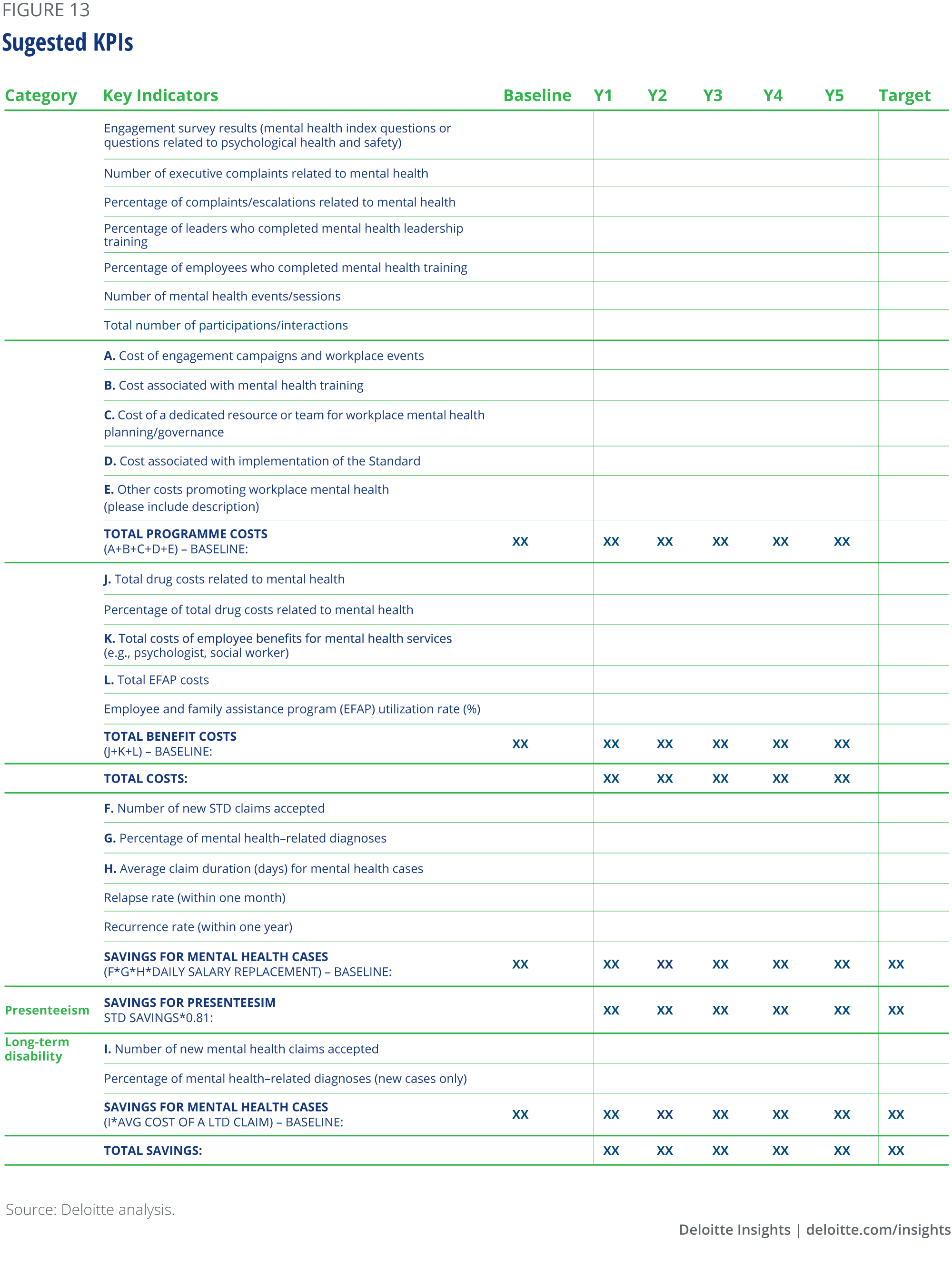
Disclaimer
The information presented in this report is based on an analysis of 10 publicly traded companies’ experiences and seven datasets spanning anywhere between three to 10 years, in addition to subject-matter adviser interviews and academic literature. As such, the results and program ROIs presented are estimates and may not reflect the experience of all companies investing in workplace mental health. While we have made attempts to verify the accuracy, completeness, and quality of information utilized for development of this report, users of this report should not rely on the contents contained therein as the sole source of information for decision-making with respect to workplace mental health programs. Deloitte is not responsible for the use of the information contained in this report by third parties.
Explore the workplace of the future
-
Talent Collection
-
If these walls could talk Article5 years ago
-
The digital workforce experience Article5 years ago
-
The alternative workforce Article6 years ago
-
From employee experience to human experience Article6 years ago
-
What is work? Article6 years ago

.jpg)










.jpg/_jcr_content/renditions/cq5dam.web.231.231.desktop.jpeg)
